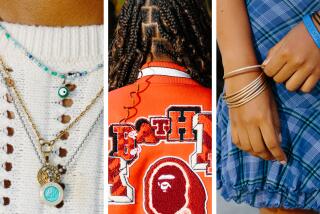Teacher Goes to Seed; Ideas Sprout
A modest salary accrues to the operation. For Warren Hatcher, though, the money is almost beside the point.
Hatcher--who is virtually if oxymoronically a full-time substitute teacher--lives simply in a single-room-occupancy hotel in downtown Los Angeles. On lesson day, he packs his gear into a large backpack and rides the RTD bus system to an assignment in one of the city’s elementary schools. The gear consists of about 150 seed-specimen boxes, 20-odd microscopes and a wealth of other teaching materials. The backpack, he admits, is heavy.
Hatcher has bought most of the seeds, found others (“I pick them up on walks in and around town”), packaged and labeled them himself. Likewise, he has bought the microscopes, at $21 apiece, out of his own pocket. Why?
“Teaching--and learning--is my passion, whether it’s history, math, geography, music or the study of seeds, which the pupils really seem to enjoy. Most of them, you know, have never seen anything through a microscope. It opens up a whole new world. I ask them to draw what they see. They say, ‘This one looks like a bug; that one like a seashell.’ ”
The pupils keep Hatcher more than occupied with questions about seeds, “but they also ask, ‘How much do the microscopes cost?’ and ‘Why do you lug that big stupid pack around on the bus?’ They have a point. I’m sure most of the other passengers think I’m some kind of homeless bum.”
Apropos, though: “Just yesterday, a fourth-grade girl said to me, ‘Mr. Hatch, what I like best is that these seeds look so ugly through the microscope, but they end up being such beautiful flowers.’ ”
L.A.: City of the Littlest Angels
Maybe it’s just the season (“He’s making a list and checking it twice. . . .”). Maybe American kids--Southern Californians in particular-- are impeccably ethical. Or maybe they’re all bald-faced fibbers.
And maybe Milton Bradley is on to a good thing. Testing the moral market for a junior version of Scruples, the game-maker polled 400 U.S. kids, ages 8 to 11, on several ethical dilemmas and concluded that the future of America is in the hands of the angels. A parallel mini-poll undertaken by The Times of Los Angeles kids reinforces the conclusion, with but a single aberration. But first, MB’s questions, with the percentage of those answering “yes” in parentheses:
“A classmate dares you to draw a silly picture of your teacher on the board before classes. Do You?” (Yes answers: Girls 1.5%, boys 6.5%.)
“One of your paper-route customers never tips. Do you sometimes toss his papers into the bushes on purpose?” (Girls 14.4%, boys 10.5%.)
“You’re flunking a course. You know how to crack the school computer and change you grade. Do you do it?” (Girls 3%, boys 6%.)
“Your job is taking tickets at a school show. Some friends want to get in free. Do you let them?” (Girls 4%, boys 4.5%).
The Southland kids polled--Chip Smith, 11, Los Angeles; Clark Schaumann, 8, Claremont; Bridget Kahow, 8, Torrance, and Lori Hribar, 11, Rancho Palos Verdes--unhesitatingly answered all questions with resounding “no’s,” save Chip’s response to the last question. “Depends on the price of the tickets,” he says. “Under $1, I’d let my friends in.” So sue.
Confronted with the evidence from Southern California, Milton Bradley rep Gail Garramone, back in New York, wondered, “Are California kids really that good?” We told her to check back after Christmas.
All Dressed Up and Someplace to Go
There’s more than one way to skin the Louvre, figures Liz Platzker.
OK, the 21-year-old from Brentwood thinks of herself more as Rodin than Ricci, more Moore than McFadden. Yet here she goes, winging her way to Paris Tuesday to compete in the sixth Air France International Concours des Jeunes Createurs de Mode (young fashion-designers competition), among whose prizes are the display of the winner’s creation in the Louvre’s permanent costume collection.
The Times caught up with Liz at a bad time: the eve of semester finals at the Rhode Island School of Design (“Risdy” to its intimates). Platzker was not hitting the books; she was sewing her fingers to the nub, coming up with a whole line of fall fashions. They don’t fool
around at Risdy.
“When I came here,” said Platzker between stitches, “I thought I’d go into sculpture. That’s my first love. But I soon found out you can support yourself better in apparel. In a way, though, it’s a financially stable way of doing sculpture. Look at it this way: Fashion is three-dimensional too. It’s wearable sculpture.”
For the record, Platzker’s entry--one of 150 by students from 14 countries--is a “hand-knit, two-piece suit of cream viscose finished with coil-ribbed collars and cuffs.”
“It’s very, very feminine,” said Platzker, “very provocative, but made for someone who also shows she has a lots of guts. As with a sculpture, the personality emerged in the making. “The one who wears it,” she concluded, “has to be someone who doesn’t need someone else to guide her; someone who’d go out there and stand on her own.” Someone like Liz Platzker.
More to Read
Inside the business of entertainment
The Wide Shot brings you news, analysis and insights on everything from streaming wars to production — and what it all means for the future.
You may occasionally receive promotional content from the Los Angeles Times.










